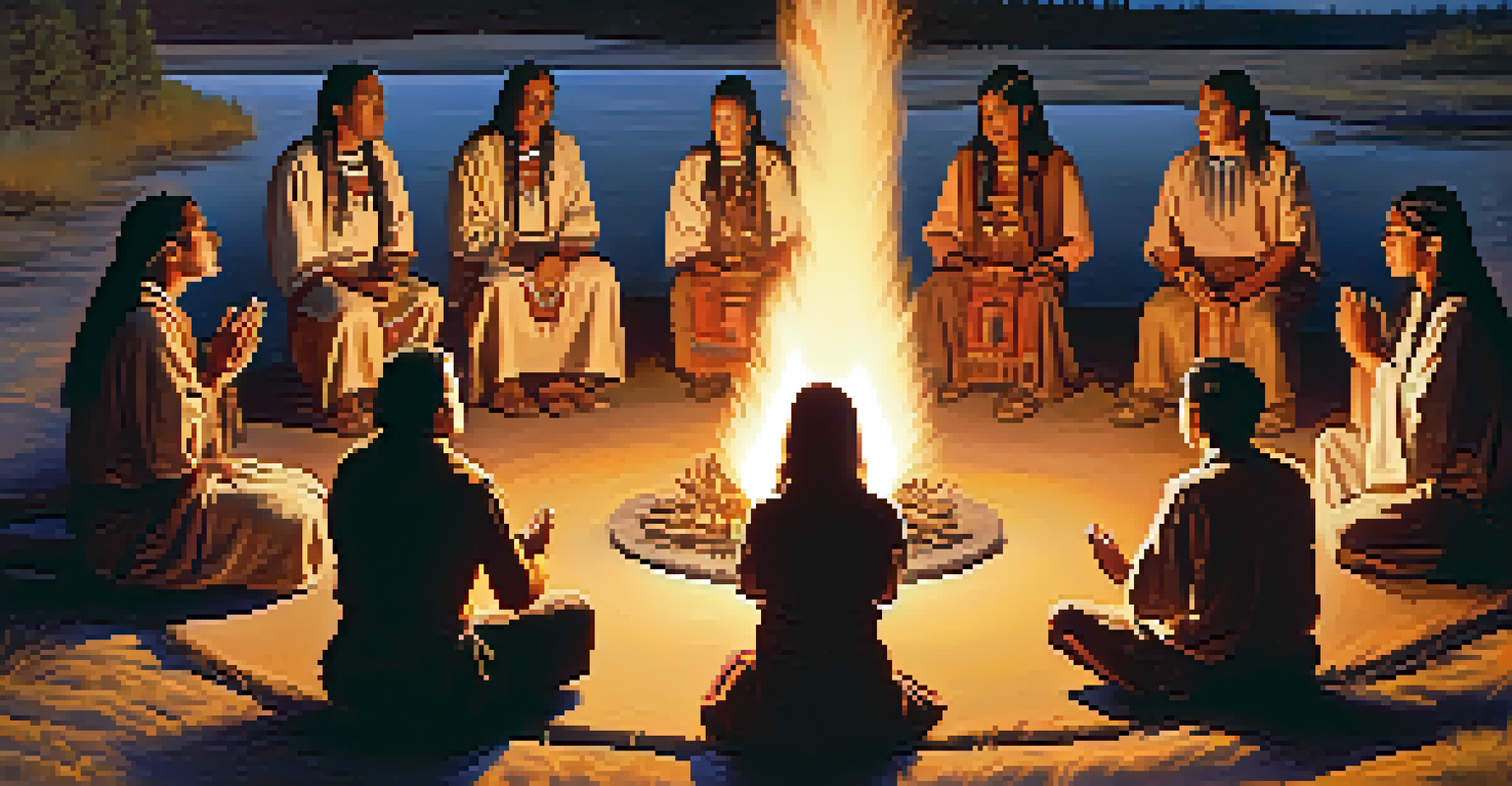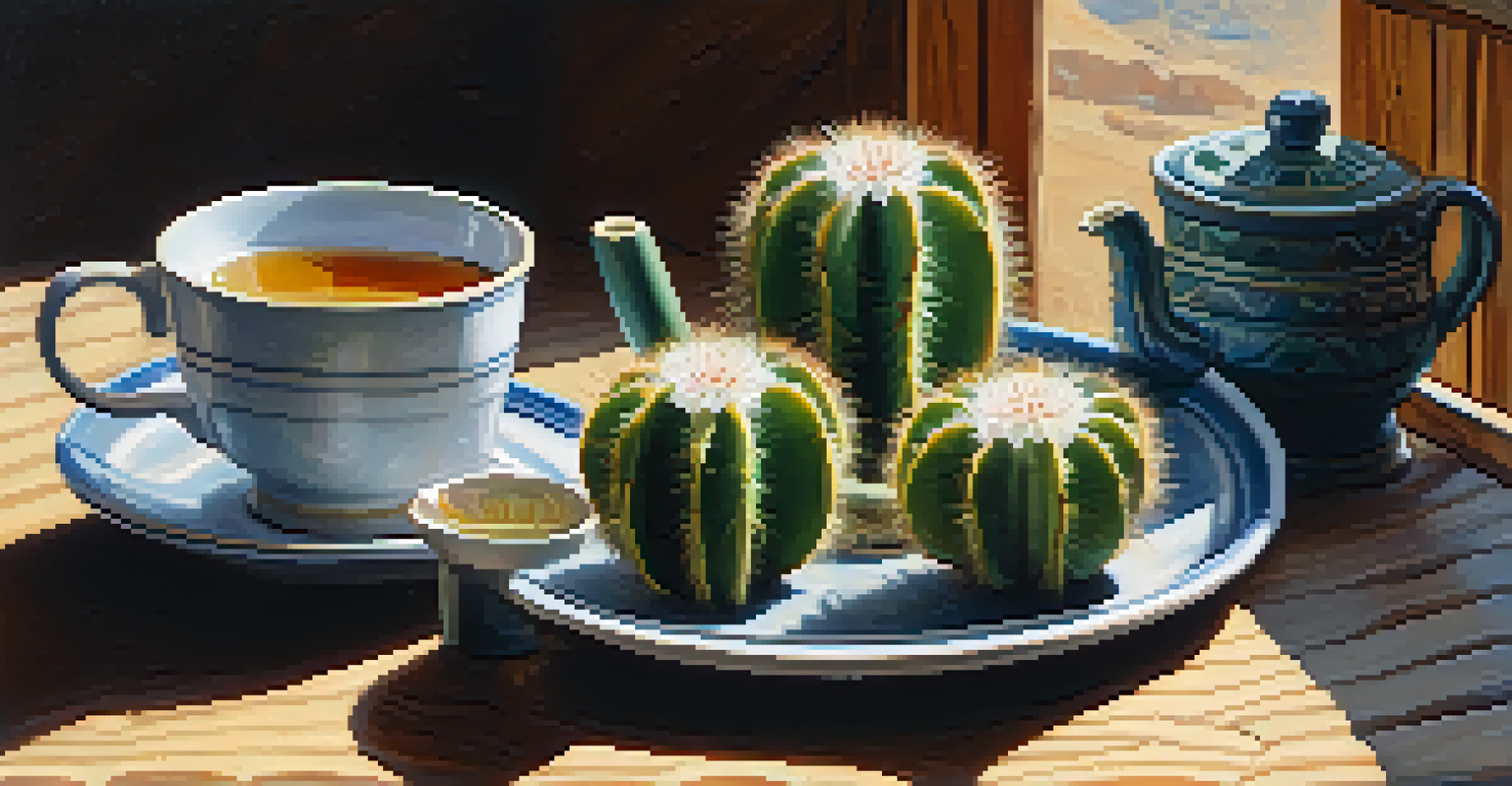The Cultural Heritage of Peyote in Native American Rituals

Understanding Peyote: A Sacred Plant in Native Culture
Peyote, a small cactus native to North America, holds profound significance in many Native American cultures. Often recognized for its psychoactive properties, this plant is not merely a drug; it is a spiritual ally used in rituals and ceremonies. The cactus contains mescaline, which induces altered states of consciousness, allowing participants to connect deeply with their spirituality.
The use of Peyote is not just about the experience; it’s about the journey of understanding one's self and the universe around us.
For many tribes, especially the Huichol and the Navajo, Peyote is revered as a gift from the Creator. It plays a central role in healing practices and religious ceremonies, offering guidance, introspection, and a heightened sense of community. By consuming Peyote in a ceremonial setting, individuals seek to gain wisdom, clarity, and a deeper understanding of their place in the universe.
This sacred plant has been used for thousands of years, symbolizing a bridge between the physical and spiritual worlds. Through Peyote rituals, participants not only honor their ancestors but also cultivate a sense of belonging and identity within their cultural heritage.
Historical Context: Peyote in Native American Traditions
The use of Peyote among Native Americans can be traced back to ancient times, highlighting its deep-rooted place in their traditions. Archaeological evidence suggests that the cactus was used in rituals as far back as 5,700 years ago in the southwestern United States. This long history underlines the importance of Peyote in religious and cultural practices across generations.

With the arrival of European settlers, the perception of Peyote began to shift. While it was initially regarded with curiosity, it soon faced opposition, leading to the criminalization of its use in the late 19th and early 20th centuries. Despite these challenges, many Native American communities continued to practice their rituals in secret, preserving their cultural heritage against societal pressures.
Peyote as a Spiritual Ally
Peyote is revered in Native American cultures as a sacred plant that facilitates spiritual connection and community through ceremonial practices.
The establishment of the Native American Church in the early 20th century became a pivotal moment for Peyote use. This organization provided a legal framework for the ritualistic use of Peyote, allowing Native Americans to freely practice their traditions while also advocating for their rights and cultural preservation.
Ceremonial Practices: The Role of Peyote in Rituals
Peyote rituals often involve a series of structured ceremonies that can last for several days. These gatherings usually take place in a sacred space, which serves as a communal hub for prayer, singing, and sharing stories. Participants consume Peyote in a respectful manner, setting intentions and opening themselves up to spiritual revelations.
To understand and respect Native American practices is to honor the deep connection between spirituality, culture, and the earth.
During these ceremonies, the Peyote is often prepared in a specific way, such as being boiled into a tea or consumed raw. The process is steeped in tradition, emphasizing the respect and reverence that participants hold for the plant. As the effects of Peyote begin to take hold, participants may experience vivid visions, emotional releases, and a profound sense of connection to their ancestors and the universe.
The role of Peyote in these rituals extends beyond individual experiences; it fosters a sense of unity among participants. By sharing stories and insights, communities strengthen their bonds and reinforce cultural values, ensuring that the teachings of their ancestors are passed down through generations.
Spiritual Insights: Lessons from Peyote Experiences
Many individuals who participate in Peyote ceremonies report transformative experiences that offer deep spiritual insights. These experiences can vary widely, but they often lead to greater self-awareness, emotional healing, and enhanced empathy towards others. Participants may find themselves confronting past traumas or gaining clarity on personal challenges.
In addition to personal growth, Peyote experiences often emphasize the interconnectedness of life. Many report feeling a profound connection to nature, fellow participants, and the universe at large. This sense of unity serves as a reminder of the importance of community and respect for all living beings.
Historical Significance of Peyote
The use of Peyote dates back thousands of years, illustrating its integral role in Native American traditions, despite facing legal and societal challenges.
These spiritual insights not only impact individual lives but also ripple through communities. People return from their rituals with renewed purpose and commitment to their cultural values, fostering a cycle of healing and growth that benefits both themselves and their communities.
Legal Challenges: The Contemporary Context of Peyote Use
Despite its historical significance, the use of Peyote faces ongoing legal challenges in contemporary society. While the Native American Church has fought for the right to use Peyote in their rituals, there are still restrictions that vary by state and federal law. This legal ambiguity often places undue stress on communities that rely on Peyote for their spiritual practices.
In recent years, there has been a growing movement advocating for the protection of native cultural practices, including the use of Peyote. Supporters argue that these rituals are essential for cultural identity and mental health, deserving of legal protection. This shift in public perception could lead to more supportive legislation in the future.
The legal status of Peyote highlights the broader conversation around indigenous rights and cultural preservation. As society continues to grapple with these issues, it’s crucial to recognize the importance of protecting and respecting the traditions that have shaped Native American cultures for centuries.
Cultural Education: The Importance of Understanding Peyote
Understanding the cultural heritage of Peyote is essential for fostering respect and appreciation for Native American traditions. Education plays a key role in dispelling misconceptions about Peyote and its use, promoting a more nuanced view of its significance. By learning about the rituals and beliefs associated with Peyote, individuals can gain insight into the rich tapestry of Native American cultures.
Cultural education not only benefits non-Native individuals but also strengthens the ties within indigenous communities. When younger generations are educated about their heritage, they are more likely to engage in traditional practices and preserve their cultural identity. This transmission of knowledge is vital for the survival of these traditions.
Cultural Education's Role
Understanding and educating others about Peyote and its cultural significance is crucial for preserving Native American heritage and fostering respect.
Moreover, cultural exchange can promote mutual understanding and respect between Native and non-Native communities. By sharing stories and experiences, individuals can bridge gaps and foster a sense of unity, ensuring that the cultural heritage of Peyote continues to thrive.
Conclusion: Celebrating the Legacy of Peyote in Native Culture
The cultural heritage of Peyote in Native American rituals is a testament to the resilience and richness of indigenous traditions. As we explore its historical significance, ceremonial practices, and contemporary challenges, we gain a deeper appreciation for the spiritual journeys of those who partake in these rituals. Peyote is more than just a plant; it is a symbol of connection, healing, and cultural identity.
As society progresses, it is vital to honor and protect the sacred practices surrounding Peyote. This includes advocating for legal rights and promoting cultural education that respects the traditions of Native Americans. By doing so, we ensure that the legacy of Peyote and its role in spiritual practices continues to flourish for future generations.

Ultimately, celebrating the cultural heritage of Peyote invites us all to reflect on our own spiritual journeys. It encourages a collective appreciation for the diverse ways in which people seek connection, healing, and understanding, reminding us that we are all part of a larger narrative of humanity.